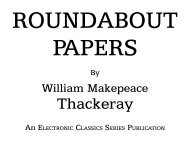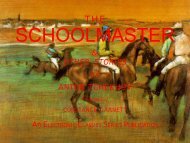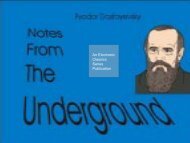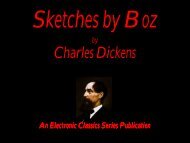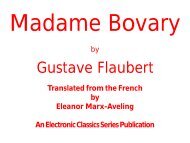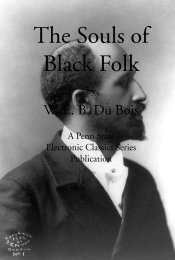A Tale of Two Cities by Charles Dickens - Penn State University
A Tale of Two Cities by Charles Dickens - Penn State University
A Tale of Two Cities by Charles Dickens - Penn State University
Create successful ePaper yourself
Turn your PDF publications into a flip-book with our unique Google optimized e-Paper software.
A <strong>Tale</strong> <strong>of</strong> <strong>Two</strong> <strong>Cities</strong> – <strong>Dickens</strong><br />
leave the law to take care <strong>of</strong> itself. I give you that advice.”<br />
“It’s the damp, sir, what settles on my chest and voice,”<br />
said Jerry. “I leave you to judge what a damp way <strong>of</strong> earning<br />
a living mine is.”<br />
“WeB, well,” said the old clerk; “we aa have our various<br />
ways <strong>of</strong> gaining a livelihood. Some <strong>of</strong> us have damp ways,<br />
and some <strong>of</strong> us have dry ways. Here is the letter. Go along.”<br />
Jerry took the letter, and, remarking to himself with less<br />
internal deference than he made an outward show <strong>of</strong>, “You<br />
are a lean old one, too,” made his bow, informed his son, in<br />
passing, <strong>of</strong> his destination, and went his way.<br />
They hanged at Tyburn, in those days, so the street outside<br />
Newgate had not obtained one infamous notoriety that<br />
has since attached to it. But, the gaol was a vile place, in<br />
which most kinds <strong>of</strong> debauchery and villainy were practised,<br />
and where dire diseases were bred, that came into court with<br />
the prisoners, and sometimes rushed straight from the dock<br />
at my Lord Chief Justice himself, and pulled him <strong>of</strong>f the<br />
bench. It had more than once happened, that the Judge in<br />
the black cap pronounced his own doom as certainly as the<br />
prisoner’s, and even died before him. For the rest, the Old<br />
Bailey was famous as a kind <strong>of</strong> deadly inn-yard, from which<br />
pale travellers set out continually, in carts and coaches, on a<br />
violent passage into the other world: traversing some two<br />
miles and a half <strong>of</strong> public street and road, and shaming few<br />
good citizens, if any. So powerful is use, and so desirable to<br />
be good use in the beginning. It was famous, too, for the<br />
pillory, a wise old institution, that inflicted a punishment <strong>of</strong><br />
which no one could foresee the extent; also, for the whipping-post,<br />
another dear old institution, very humanising and<br />
s<strong>of</strong>tening to behold in action; also, for extensive transactions<br />
in blood-money, another fragment <strong>of</strong> ancestral wisdom,<br />
systematically leading to the most frightful mercenary<br />
crimes that could be committed under Heaven. Altogether,<br />
the Old Bailey, at that date, was a choice illustration <strong>of</strong> the<br />
precept, that “Whatever is is right;” an aphorism that would<br />
be as final as it is lazy, did it not include the troublesome<br />
consequence, that nothing that ever was, was wrong.<br />
Making his way through the tainted crowd, dispersed up<br />
and down this hideous scene <strong>of</strong> action, with the skill <strong>of</strong> a<br />
man accustomed to make his way quietly, the messenger<br />
found out the door he sought, and handed in his letter<br />
54




